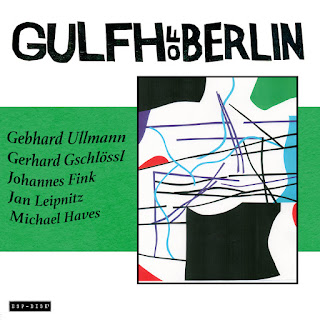By Paul Acquaro
While part 1 of this feature focused on German saxophonist and bass clarinetist Gebhard Ullmann’s acoustic work, part 2 considers his recent electronic leaning work. We begin by going a bit further back, to 2021 and then shoot ahead into the near future…
GULPH of Berlin – self titled (ESP Disc’, 2021)
Ok, so this one was released mid-pandemic in Fall 2021, but it deserves to
be a part of this survey, especially since the release concert just finally happened
in late 2022 at the B-flat jazz club in Berlin. The premise of this band –
aside from the excellent inclusion of euphonium and tricked-out cello – is
the extensive use of a live electronics. In fact, that last
point is the main difference between the 2014 release of GULF of Berlin
(Jazzwerkstatt) which featured 4/5th of the current line-up.
clarinet, Jan Leipnitz on drums and objects, Johannes Fink on
double bass and cello, and now Michael
Haves’ with live sound processing.
extensive electronic set up. While everyone experimented with various electronics, drumming on the sound monitors, or placing all sorts of objects into their
instruments, the real game changer was Haves. As the band played, were fed back their
own sounds reprocessed, creating both an atmosphere and fifth instrument. This same dynamic permeates the recording, creating a prism of sounds and refracted possibilities.
become dense and impenetrable (‘Joja Romp’), there are many instances of it
also being vulnerable (‘GG’) or quite interconnected and
responsive, showcasing the trombone, cello, bass clarinet and sax
(‘Tellus’). The track ‘5 Elements’ is the most rocking too – Fink’s cello
becomes a precision weapon, focused and fierce and locked tight
with Leipnitz’s drumming, while Ullmann and Gschlössl engage in an improvised melee.
Das Kondensat – Andere Planeten (Why Play Jazz, 2023)
writing, the April 7th release date is still a few weeks off), but also in
terms of the musical vision. Das Kondensat is Ullmann’s
adventurous electro-acoustic outfit that leans quite heavily to the electro
side and Andere Planeten, their third release, travels even
further out from the time-bending sounds of their previous recordings.
Here, keyboardist Liz Kosack adds her other worldly synthesizer sounds to the collective explorations of
Ullmann, bassist Oliver Potratz and drummer Eric Schaefer, all who also add varying layers of electronics and effects. Recorded
directly after the sessions for their 2020 release, Das Kondensat 2 (Why Play Jazz), the explorations on Andere Planeten
offer a whole different perspective.
Planeten,’ Ullman’s sound is yearning and layered over celestial
ambience. The follow up, ‘Otari 1970,’ on the other hand, delivers a rhythmic punch
that suggests their previous work. Then, tracks like ‘Impromptu #4’ venture
into uncharted territories with the help of Kosack’s sly melodies,
Ullmann’s bifurcated tones, and the telepathic communication between
Potratz and Schaefer. ‘K2-9b’ starts off with the heavenly sounds of droids singing, turns
into a rollicking rocker a few minutes in, while its follow up, ‘Proxima b,’
seems like an long awaited update to Weather Reports’ ‘I Sing the Body
Electric’ – by which one can assume it is pretty damn fine.



